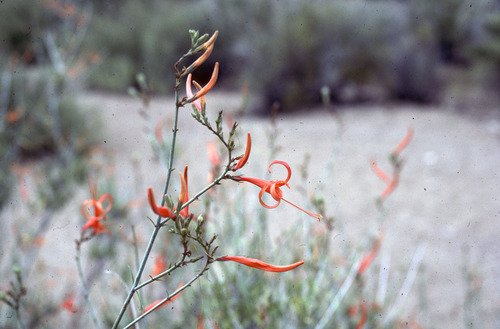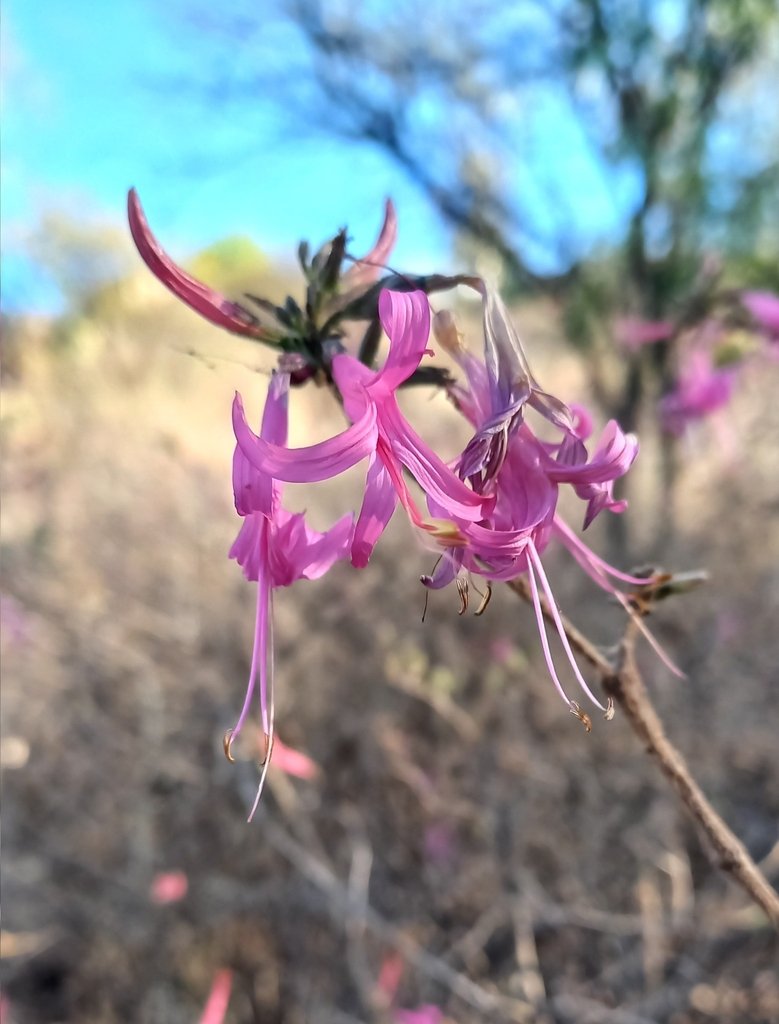The Genus Anisacanthus
These plants are collectively known as honeysuckles, though the common name “honeysuckle” is a bit overused, and refers to so many unrelated plants, that it’s tempting to come up with new names for these plants. Members of the genus are native to tropical and subtropical regions of the Americas, and there are 13 accepted species. All are excellent plants for hummingbirds.
Butterfly larval hosts for the following species:
Rosita Patch (Chlosyne rosita)
Arizona Checkerspot (Texola perse)
Anisacanthus andersonii
Big Honeysuckle
Semi-evergreen, upright-growing shrub reaching 3-8’ high and slightly less wide. Winter into spring this plant blooms with very long orange, pink, or red tubular flowers.
Full sun to bright shade, though more sun will produce more flowers. Moderate water. Hardy to 20°F though temperatures in the upper to mid 20s will defoliate plants and damage tips.
Flowers loved by hummingbirds and butterflies. Butterfly larval food plant for the elada checkerspot (Texola elada) and the Arizona checkerspot (Texola perse).
The generic name is derived from the Greek words ανισος (anisos), meaning "unequal," and ακανθος (acanthos), meaning "thorn." The species name honors Charles Lewis Anderson who was an American medical doctor that, in addition to the practice of medicine, made important contributions to fields of natural history, especially botany.
In rocky canyons and slopes, mostly found in the Sierra Madre, northern Mexico. There is rumor of it occurring in Arizona, which is where our plants were supposedly from (Palm Canyon).
Anisacanthus linerais
Narrowleaf Honeysuckle
Deciduous shrub usually growing to about 3x3’ but sometimes grows as large as 10’ though plants take well to pruning. From June to December this plant can display red, tubular flowers.
Full to part sun, moderate water, hardy to about 10°F.
Loved by butterflies and hummingbirds. Butterfly larval food plant for the elada checkerspot (Texola elada) and the Arizona checkerspot (Texola perse).
The generic name is derived from the Greek words ανισος (anisos), meaning "unequal," and ακανθος (acanthos), meaning "thorn." The species name, linearis, means linear and refers to the foliage which is narrower than the other species of Anisacanthus.
Native to canyons and along dry stream beds and arroyos in Texas, south into Chihuahua, Coahuila, and Nuevo Leon.
Anisacanthus puberulus
Big Pink Honeysuckle
Deciduous shrub, sprawling from about 4 to 10’ tall and wide! In Texas there are dwarf varieties available but they have not made their way to our market yet.
Full to part sun; more sun will produce more flowers. Moderate to regular water in the low desert. Reputed to be hardy to 10°F but we know of plants that have gone below 0°F.
Attracts hummingbirds and other nectar-seeking insects. Butterfly larval food plant for the elada checkerspot (Texola elada) and the Arizona checkerspot (Texola perse).
The generic name is derived from the Greek words ανισος (anisos), meaning "unequal," and ακανθος (acanthos), meaning "thorn." The species name, puberulus, is a descriptive term for plants that have short, soft hairs—this species has hairs on the foliage which can be properly seen with a lens.
High elevation canyons, ditches, ravines, and depressions, thickets, rocky banks, washes in Texas and adjacent Mexico in Chihuahua and Coahuila.
Anisacanthus quadrifidus
Flame Honeysuckle
Deciduous shrub, 3-5’ tall and wide. Throughout most of the warm season, long tubular red flowers bloom, heaviest in late summer to fall. Plants reseed readily in the landscape.
Full sun to bright shade (more sun produces more flowers. Moderate to low water when established. Hardy to 0°F.
Hummingbirds love this plant as do other nectar-feeders. Butterfly larval food plant for the elada checkerspot (Texola elada) and the Arizona checkerspot (Texola perse).
The generic name is derived from the Greek words ανισος (anisos), meaning "unequal," and ακανθος (acanthos), meaning "thorn." The species name of this plant is for Charles Wright, 1811-1885, world-wide botanical collector who collected extensively in Texas (1837-1852), Cuba, and his native Connecticut.
The northernmost variety of its species, Anisacanthus quadrifidus var. wrightii, is native to rocky banks and floodplains of streams, shrublands (matorral), and grasslands from south-central and west Texas into northern Mexico. The species, Anisacanthus quadrifidus, continues south to Oaxaca in southern Mexico.
Desert Honeysuckle
Anisacanthus thurberi
Semi-evergreen shrub, 6x5’ blooming in the warm season into fall with tubular, coppery orange, sometimes almost red flowers (rarely plants have yellow flowers).
Full to part sun, bright shade. Moderate water. Hardy to 10°F.
Hummingbirds love the flowers as well as other nectar feeders. Butterfly larval food plant for the elada checkerspot (Texola elada) and the Arizona checkerspot (Texola perse).
The generic name is derived from the Greek words ανισος (anisos), meaning "unequal," and ακανθος (acanthos), meaning "thorn." The specific epithet "thurberi" is named to honor Dr. George G. Thurber, (1821-1890), American pharmacist, self-taught botanist and avid plant collector. He was hired in 1850 by the U.S. Boundary Commission to survey the boundary between the United States and Mexico.
Rocky canyon bottoms and gravelly or sandy washes from 2,000-5,000 ft. in Arizona, southwestern New Mexico, south into central Mexico.





